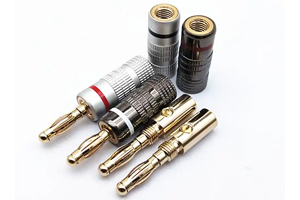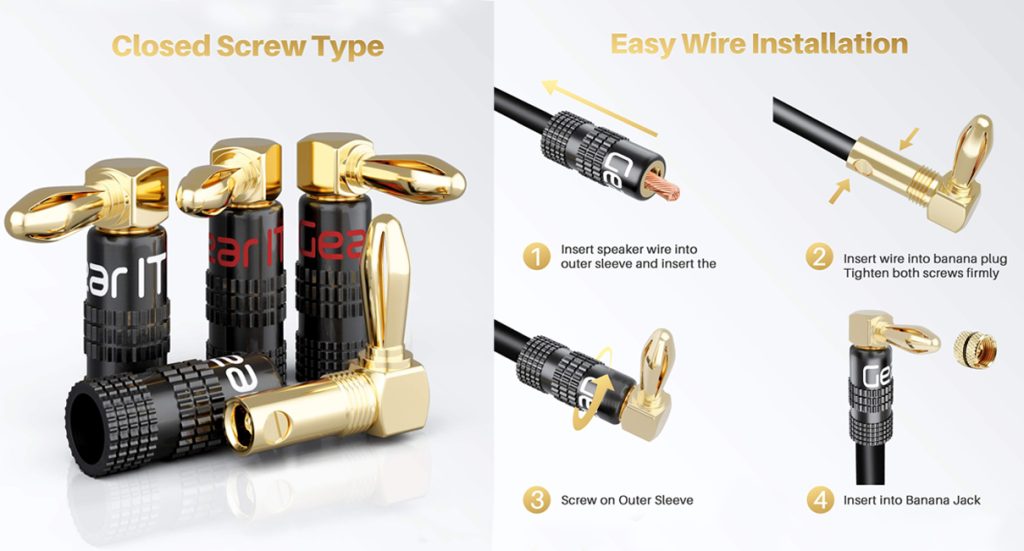How Do Banana Plugs Work? A Detailed Guide for Correct Use
Author:admin Date: 2025-05-13 08:13 Views:456
Banana plugs are quite common, but not many people use the name banana plug. However, these are electrical connectors with a cylindrical spring-loaded tip that looks like a banana once inserted into a corresponding socket. You should expect to come across such a connector in test and audio equipment.
What Are Banana Plugs & How Do You Use Them?
Basic Components of Banana Plugs
一個 banana plug will have several components to make it work as expected. Such include metal pins, springs/leaves, plastic housing, and a wire connection.
The metal pin on speaker banana plugs is the core of the plug. It is made of conductive material such as brass and can be gold-coated to improve conductivity. The standard diameter for the pin is around 4mm.
The springs of banana plugs for speakers are on the cylindrical pin. They are designed to bulge outwards when you insert the plug into a socket. This bulging is crucial for ensuring you get a tight and secure connection for electrical systems.
A plastic housing is vital for surrounding the metal pin and springs to provide physical protection and insulation. Expect this housing of banana plugs for speaker wire to be made of durable plastic and can have multiple colors for ease of identification.
As for the wire connection, it is how the wire is connected to the banana plug. It can be through crimping, soldering, or screwing. Whichever method is used, ensure there is a strong connection for the proper performance of the device.
Features of Banana Plugs
Banana plug connectors are now a standard for connecting speaker wires, but they can also be used for other purposes. Their features make them great options for different applications.
The banana shape gives the plug a distinctive appearance and performance. The shape houses the spring, which flexes outward when inserted into a socket, providing a tight and secure connection.
These plugs are also built for durability. Expect to find brands making solid banana plugs that can work for various applications. Although the standard size for the metal pin is 4mm in diameter, you can get other sizes to suit your needs.
Multiple types of banana plugs are also available. This includes closed screw plugs and open plugs. Each works differently to achieve the same results. You may also consider banana plugs adapters, which connect other types of connectors with the banana plugs.
Common Types of Banana Plugs

Before installing banana plugs with speaker wires, it is essential to understand the common types available to choose the right one. The key types of banana plugs include:
1. Closed Screw Banana Plugs
This design of banana plugs involves having two cylindrical parts that screw together to offer a tight connection. The wires for these plugs enter from the rear of the plug and are then screwed into position. This makes them enclosed by the plastic casing, protecting them from the elements and possible interferences. This makes the connection secure, thus common for speakers and audio equipment.
2. Open Screw Banana Plugs
These are the opposite of the closed screw banana plugs mentioned above. For this one, the cable is inserted through a side entry hole. It still provides a good connection, but people now prefer the closed screw banana plugs for reliability.
3. Gold-plated Banana Plugs
The gold-plated plugs have high electrical conductivity and an attractive appearance. Gold plating is common for metals such as brass to improve their performance.
4. Solder Type Banana Plugs
As the name suggests, you simply attach a wire to the connector through soldering. If the soldering is done right, this process often leaves you with a strong and reliable connection.
Expect to come across other types of banana plugs primarily based on their functionality, but those mentioned above are the key options in the market.
Benefits of Using Banana Plugs
一個 banana plug connector will have many benefits compared to some other types of connectors in the market. This comes down to how they are used and the type you choose. Here are some practical benefits.
- The simplified connection makes it easy to use the plugs. Even those new to such connectors should have an easy time using them.
- There is enhanced safety as well. The plugs eliminate the stray wire strands, which could easily lead to short circuits. Also, you get color-coded plugs to help prevent connection errors.
- Expect a secure connection that helps maintain a reliable contact. The spring-loaded design keeps the plug from easily dropping out of its socket.
- The plugs are generally good for signal integrity, which is why they are used for speakers and test equipment. You will find options such as gold-plated contact keys to prevent oxidation of the connection points, thus ensuring signal quality is maintained.
- Expect the equipment to keep working even with vibrations to understand how good the connection is. For example, when you use plugs for speakers that keep vibrating while playing music, you should still experience impressive signal quality.
Applications of Banana Plugs
The most common application for banana plugs is the audio and speaker connections. You can use these plugs to connect speakers to speakers, receivers, and amplifiers. They are commonly used for such connections to ensure quality performance and reduce signal loss.
Other applications of banana plugs include:
- Testing and measuring equipment such as multimeters
- Model railway applications
- Medical equipment and test kits
- Telecom sectors to enhance signal quality
How to Install and Use Banana Plugs

Closed Screw Type Speaker Banana Plugs Easy Wire Installation

Closed Screw Type Easy Wire Installation
No matter the application, the process of how to install banana plugs is usually similar. Here is how to do it.
- Prepare the cable you want to install in a 4mm banana plug. You do this by stripping the insulation from the speaker wire and exposing about 1cm of bare copper or brass.
- Insert the stripped part of the wire into the banana plug. You have to loosen a screw or remove a cap to see where to insert the wire. Ensure it is a good fit.
- Proceed to secure the wire by tightening the screw or sliding the cap back onto the plug to ensure a secure connection.
- Connect the banana plug to the required socket and test the connection to see how it works. So long as you tightened the screw or soldered the cable correctly, you should have no problems at all.
How to Choose the Right Banana Plugs
Whether you choose a speaker banana plug or any other type, it must be done correctly. Below are key considerations for selecting the right banana plugs.
Size and Compatibility
You will find several types of banana plugs on the market, all in different sizes. The 4mm is the most common, but there are also other sizes. So, choose the right size that is compatible with the application in mind.
Connection Types
We have mentioned the types of banana plugs on the market before. With that in mind, you can know which connector type will work best.
For example, the screw type is convenient and affordable for most basic setups. You can also consider the compression type to balance reliability and ease of use.
The solder types are considered more secure and offer a reliable connection, mainly for professional audio systems.
Material Quality
The gold-plating is just one of the materials that can be used for banana plugs. This is because it leads to excellent conductivity and further resists corrosion.
The other materials used for their conductivity and durability include copper and brass.
絕緣
Look at the type of insulation you get with banana plugs. The casing with banana plugs is the best, as it offers cable protection while ensuring a secure connection. You can still get a heat-shrink sleeve key to prevent short circuits and electrical interference.
How to Troubleshoot Banana Plugs
Sometimes, you need to know how to wire banana plugs so that it becomes easier to troubleshoot them in case of an issue. Below are some troubleshooting ideas in case your banana plug is not working as expected.
- Check for loose connections. Look at the tension springs to see if they are still holding tight. You can re-tighten the screws to ensure there is good contact and performance. Some use electrical tape to help increase the friction needed to retain the plug.
- Inspect the plugs and prongs to ensure they are free of damage. Sometimes, broken or collapsed prongs can make the connection less secure, and the plug can easily fall out. If the damage is severe, replacing the plugs is highly recommended.
- Is the banana plug correctly installed? If not, follow the guide on how to install the speaker banana plugto ensure it is done right. Also, strip the wires correctly to ensure a tight fit.
- Do a pull test on the connections. This is done by gently pulling the wires to see if they fit securely. Also, check for loose wires and tighten them where necessary.
結論
Banana plugs remain essential for various types of connections. They could connect audio equipment or test equipment in a lab. All we know is that the connection is usually secure and tight. This is vital for the equipment’s overall performance, especially for maintaining signal quality. Look for banana plugs from top brands to ensure you get high-quality options and proper performance.
請發送 RFQ,我們將立即回覆。
常見問題
Banana Plugs vs. Spade Connectors vs. Bare Wire. Which one is the best?
These three can be used to connect devices. Banana plugs offer a strong and secure connection. They are also easy to change and move, but they can have less surface area contact than spade connectors.
The spade connectors offer good binding for post terminals and are also easy to install and remove. However, it can also become loose if not appropriately secured.
Bare wire is for straightforward connections and can be cost-effective. However, it is prone to oxidation and requires more effort to manage. Expect it to be used for casual systems where cost and simplicity are priorities.
Can banana plugs improve audio quality?
The plugs do not directly improve audio quality but rather maintain it from the source. So, first, make sure the source offers excellent audio quality, and then the plugs retain it for the receiver.
Do all speakers and receivers use banana plugs?
Not all speakers and receivers have banana plug-compatible sockets. However, if you can find some with such features, you should have good performance over the years without a problem.
Are banana plugs available in multiple sizes?
Yes. The 4mm diameter is the standard option, but many other sizes are on the market. It comes down to what fits into your equipment. You can check the equipment manual to see what works best for it.


